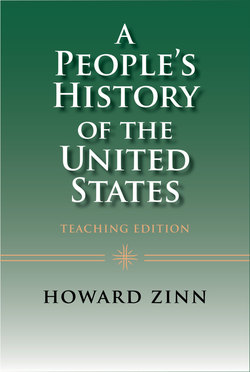Читать книгу A People's History of the United States: Teaching Edition - Howard Boone's Zinn - Страница 9
На сайте Литреса книга снята с продажи.
How to Read This Book
ОглавлениеEvery teacher needs to develop his or her own style and method. But no style or method can be created in a vacuum. I have provided methodological suggestions from which you may pick and choose. At the end of each chapter there are “study guide” questions, and at the end of the book there are four appendices. Appendix A includes suggestions for teaching a group paragraph, a suggested system of assessment (i.e. giving grades), a commentary on the uses and abuses of extra credit, the role of geography in a history class, useful approaches to using the debate format in teaching content and critical thinking, and techniques for class discussion. Appendix B provides a specific example of how standard American history textbooks differ. Appendix C provides a highly selective and annotated list of additional resources. Zinn allows the teacher to help students raise questions that require further research. Appendix D is an idiosyncratic but intriguing introduction to Bloom’s taxonomy.
The questions at the end of each chapter are of several kinds—some simply ask the reader to extract detail,4 while others demand that students do more than accumulate knowledge and gain comprehension. They ask students to analyze the text, select relevant data, synthesize that data into an answer, and then evaluate the answer. The higher order questions provoke the most interesting discussions since they demand that students begin to attach meaning to the data and detail.5
In the years I have been using history to teach critical thinking, I have discovered that moving back and forth between the concrete and the abstract (inherent in both deductive and inductive thinking) is a skill that needs to be explicitly taught. A few students are “naturals,” but most need to be shown how it is done and they need a great deal of practice doing it. Constantly asking students to define the terms6 of their questions and statements is a crucial first step in developing this kind of thinking. Many of the questions after each chapter therefore ask the reader to define the terms Zinn uses or certain terms the historical actors used. Questions requiring analysis and synthesis require that the terms of the question be fully understood.
To illustrate this point let me examine one of the questions from the chapter on Reconstruction. I ask “After the Civil War, was the South reduced to colonial status?” Before a student even begins to look for an answer to this question, several of the terms need to be understood in a very concrete way, in particular the word “colonial.” Depending on how one defines “colonial,” the answer could be yes or it could be no. If the teacher and student share the same definition of “colonial” then the teacher is more likely to approve of the student’s answer. To explicitly define the essential terms of a question avoids misunderstanding and ensures a greater likelihood of success by the student.
A teacher might use the above question for discussion in class, as a topic for a group paragraph, or as written homework. Regardless of the actual form of an assignment, the process of completing it needs to be taught (repeatedly and consistently throughout the year). Break the question down into its discrete terms. For example, “the South”—identify the states to which the question refers; “after the Civil War”—identify the time period during which the South’s “status” is being assessed. Then tackle the thornier problem of defining “colonial.” For this, a dictionary can be useful. But use historical precedents in tandem with the dictionary. The American states used to be English colonies. What was their status in relation to England? (A politically dependent territory used as a source of raw materials and a market for manufactured goods?). Merriam Webster’s Collegiate Dictionary provides several choices of definitions for the word “colony.” Which one best fits the historical context?
a body of people living in a new territory but retaining ties with the parent state
a group of people institutionalized away from others
a dependent area or people controlled, dominated, or exploited by a parent state?
Once the terms are defined so their applicability to a specified group of historical data is clear, students previously unable to complete the question on their own will now be able to do so.
There are a few questions I have asked herein to which Zinn does not provide the answer. For example, after Chapter 9 in question 26, I ask, “Was the Georgia legislature successful in expelling its black members?” The text indicates that the legislature made the attempt. We don’t know if the attempt was, in fact, successful. This is what students sometimes call a “trick” question. But if one’s goal is to empower students, this kind of question teaches students to read carefully.
Another skill introduced and reinforced by some of the chapter questions is that of being able to categorize data, for the purposes of then synthesizing it and evaluating economic, political, social, and cultural factors. Most standard texts keep discussion at the political level, and most students are thus not used to thinking in terms of economic and social causes and consequences. But an important component of critical thinking is establishing relationships.7 Zinn’s data and explanations provide a wonderful opportunity to teach students how to develop a socioeconomic analysis of political events. Zinn hopes that the development of such thinking about the past will lead to such thinking about the present. It does.
